Field Strength Measurement.
Offer magnetometers, gaussmeters, milliteslameters, milligaussmeters, residual field indicator . To measure the AC and / or VC magnetic fields to measure the Earth's field, to monitor cargo aviation air transport, etc.
| model | foto | description |
|---|---|---|
|
Residual Field Indicator 20-0-20 gauss (MAC, USA) |
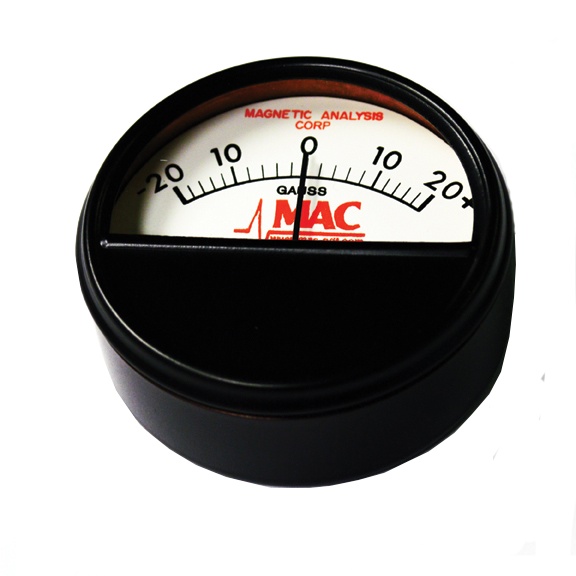
|
• To Indicate Residual Magnetism in Iron and Steel Objects The Magnetic Analysis Magnetism Detector is widely used by steel suppliers and fabricators to indicate the degree and polarity of residual magnetism in ferrous products. Easy to use, simply place the base of the indicating needle against the object you are testing. The needle indicator will move to a point on the scale that represents the strength of the magnetic field of the material (in gauss). The meter scale reads 20 units on either side of a zero center point, allowing for quick identification of the field’s polarity as well as the level of the magnetic field. Full scale deflection is equal to approximately twenty gauss. When checking magnetized bar stock or tubing, a reading of 10 or less is usually acceptable. Each piece should be tested separately, however, so that the reading is not affected by adjacent parts. • Sensitivity & Calibration Magnetism Detectors are calibrated prior to shipment, as signified by the sticker applied and initialed by a member of MAC’s Quality Control staff (does not come with a certificate of calibration). Calibration to a Level of +/- 1 gauss at 10 gauss is performed utilizing a calibration fixture, calibrated with a gauss meter which has been calibrated in accord with standards traceable to the N.I.S.T. For those applications where the sensitivity of the instrument, as supplied, is of high significance, the full-scale reading (+/- 20) is obtained when the meter is subjected to a field whose known intensity is 20 gauss. (Calibration Certificates are available upon request at time of order.) • Dimensions, mm Ø 50, high 22 • Weight, kg 0,06 |
|
Magnetic Field Indicator MG-25-50
(Parker, USA) |
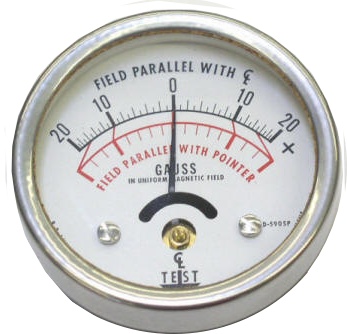
|
• All MG-25 Magnetic Field Indicators can be certified in accordance with ASTM E1444. Calibration includes readings taken at three points in each range and each polarity including zero.
• Calibration/certification may be ordered when the instrument is purchased, or the instrument may be returned for recalibration/certification. • Range, gauss +/– 50 • Dimensions, mm Ø 50, high 22 • Weight, kg 0,06 |
|
DIGITAL GAUSS METER
(WALMAG, Czech Republic) |
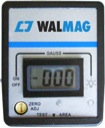
|
• Measuring range from 0 up to 999 Gauss • Indication of magnetic polarity • Display light • Dimension 76 x 61 x 24 mm • Battery: 9 VDC • Battery life: 72 hours of uninterrupted working, several months of normal usage |
|
Gauss meters series Bell 5100 (F.W.Bell,USA) |
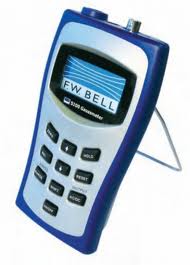
|
• Suitable for accurate and fast measurement of AC and DC magnetic fields. • Bell 5170 and 5180 are equipped with an active LCD display, which displays all the necessary parameters and values clearly even in the degraded conditions of illumination. • You can work with an accuracy of 1% and apply the function Auto Zero, Min. / Max. / Peak, Hold, Auto Range, True RMS (true RMS readings), True Peak (true peak) and Relative Mode (relative measurements). • Both devices have similar basic functions, units of measurement Gauss, Tesla, Amps / m. • Model 5180 except all equipped with an analog output (± 3 FS), and communication port USB. • All devices are supplied with the standard reset, manual, carrying case, four AA batteries, the CE certificate and the reference sensor.  Details
Details
|
|
DC Gaussmeter Model GM1-ST
(AlphaLab, USA) |
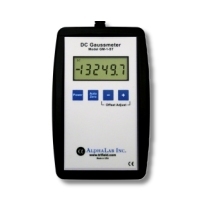
|
The Gaussmeter Model GM1-ST measures the field of even the strongest magnet (to 20kG) down to fine resolution (0.1G). Features rapid turn-on and fast update. This model supersedes the MD1-ST, which had no auto-zero. • High dynamic range 5 ½ digit display reads even the strongest magnets with .1 gauss resolution, including polarity. • Turns on instantly, updates four times a second, no setup or initial calibration required. • Auto-Zero (subtracts the present field from subsequent readings); also a fine offset control. • Offset range is the full +/- 19,999.99 gauss. • 1% accuracy at room temperature, including probe. • Probe and battery included. • Optional rubber boot and hard carrying case are available. • CE Compliant.  Details
Details
|
|
Gaussmeter Model GM2 (AlphaLab, USA) |
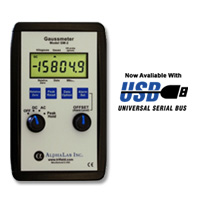
|
Laboratory gaussmeter that reads field, true peak field, AC field, and has an alarm. Range is 30,000 gauss.
• High dynamic range: can measure even a small variation in a large DC, AC or peak magnetic field. • Programmable alarm will sound either if field exceeds a level you set or if the field is between lower and upper levels you set. • Intuitive to use with rapid turn on, fast update. Begin reading DC field, AC f field, or peak field just by turning the knob. No setup or calibration required. • Peak hold function shows the highest DC level with fast 0.002 sec capture window; also displays polarity of the peak. • Interchangeable probes: range 30k G with ST probes; 800 G (0.01 G resolution) with HS probes. • Runs on battery or AC adapter (included). • Includes analog output connector, certificate of calibration. • CE Compliant.  Details
Details
|
|
Vector/Magnitude Gaussmeter Model VGM (AlphaLab, USA) |
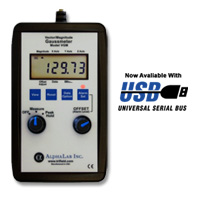
|
• Displays the magnitude of magnetic field regardless of probe orientation. Also can display X, Y, or Z components. • When set to “Peak Hold”, displays the highest magnitude since the last time “Reset” was pressed. Also remembers and can display peak value of X, Y, Z (including polarity) since the last "Reset." • Continuous sampling and magnitude calculation every 5 milliseconds; the peak of X, Y, Z and magnitude will be accurate even if they occurred at different times. • Sound alarm and light for rapid feedback if the field exceeds threshold you set. • Relative zero and manual offset functions independently for X, Y, Z. • Includes battery, AC Adapter, alarm output (open/closed switch) • CE Compliant.  Details
Details
|
|
DC Milligauss Meter Model MGM (AlphaLab, USA) |
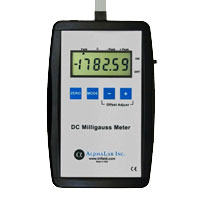
|
An improvement on the flux gate magnetometer, the DC Milligauss Meter measures magnetic fields (technically “flux density”) up to several times the strength of the Earth field. It has a resolution of 0.01 milligauss (1 nanotesla) and a range of +/-2000 milligauss (200 microteslas). The meter's magnetoresistive sensor is a major improvement over an uncompensated fluxgate magnetometer both in cost and stability. In fact, this sensor approaches a proton precession magnetometer in temperature stability. However, at only 1 mm x 0.2 mm, the active sensor area is much smaller than fluxgate magnetometer or proton sensors. This allows very precise magnetic measurements in small areas (such as thin films) or with high gradients, when necessary. The display is 5 1/2 digits, which reads from -1999.99 to +1999.99 milligauss, with resoulution 0.01 milligsuss over the entire range. (Compare to the Earth field, which is on the order of 500 milligauss). Update is three times per second. This wide dynamic range of the display (199,999 counts; both polarities), and high stability of the meter allow for stable detection of small changes in a large background field. The sensor is at the end of an eight-wire cable that is normally four feet long, but other custom lengths are available. The sensor is “axial”, which means it detects the component of the field that's in the same direction as the cable points (see arrow photo). The meter reads negative when the sensor is pointing toward the south pole of a magnet and positive toward north. The small active area of the sensor is in the center of the dark square. At fixed temperature, reproducibility is +/- 0.01 milligauss (1 nT) and the temperature coefficient of the offset is less than 0.01 milligauss/°C. The temperature coefficient for gain is less than .0015%/°C. As shipped, gain accuracy is +/-0.5% and the meter offset is +/- 0.5 milligauss. All specifications are at temperatures 0 to 45°C. Size is approximately 18(high) x 9(wide) x 5(thick) cm. Weight, including battery is 325 grams. See photo for the external sensor dimensions.  Details
Details
|
|
The Air Shipment Milligauss Meter (Oersted Meter) (AlphaLab, USA) |
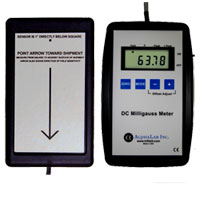
|
This meter is used to verify compliance with IATA, IACO and FAA regulations on magnetism from packages to be shipped by air.*
The Air Shipment Milligauss Meter has been designed so that one person alone can be the tester, and do repackaging, if necessary, without moving from the area. The remote sensor, shown on the right side, is connected through a 15-foot cable to the control box (left). This control box is placed next to both the package and the tester (person) so the tester can manually rotate the shipment. The remote sensor is placed either 15 feet or 7 feet away, depending on which test is being done. Using knobs on the control box, the meter is first set to zero without the air shipment present. This compensates for the field in the room (including the earth's field). This “zero” adjust remains accurate until the sensor is moved or if something large and magnetic is moved nearby. After zeroing, the package is brought in and rotated (in a “lazy Susan” manner) 360° on the floor. As the package is rotated, the tester is watching to see if the display ever reads over “5.25” or “-5.25” milligauss, or “2.00” or -2.00”, depending on which test is being done. With the fast update speed of the numerical display, the whole test requires about 20 seconds, including 360° rotation. The meter is performing “relative” field measurements when used as described above (where the meter detects up or down deviations of the field relative to the normal room field). In addition, this meter can perform absolute field measurements of up to +/-1500 milligauss (compare to the earth field of 200 to 600 milligauss). This absolute measurement function is handy for checking the effectiveness of demagnetization steps and for other research and process monitoring with magnetic materials. The Air Shipment Milligauss Meter is accurate +/-2% of reading in the temperature range 30°F - 120°F or -1C to 49C (IATA and FAA regulations only require +/-5%) and comes with certification traceable to NIST. It has a 4 ½ digit display which reads up to +/-199.99 or +/-1999.9 milligauss (selected by the RANGE knob. Accuracy guaranteed up to +/- 1500 milligauss). *The regulations state that any package that has a horizontal magnetic field greater than 5.25 milligauss at a distance of 15 feet from the surface of the package cannot be shipped by air or must be repacked to be below 5.25 milligauss. If the field is below 5.25 milligauss at 15 feet but above 2 milligauss at 7 feet, the package can be shipped, but must be labeled as magnetic. If below 2 milligauss at 7 feet, it can be shipped without labeling or any other restriction.  Details
Details
|
|
Trifield ® Meter Model 100XE (AlphaLab, USA) |
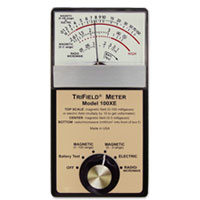
|
Trifield ® Meter measures all three types of electromagnetic field: AC magnetic field, AC electric field, and radio (including microwaves). The magnetic and electric detectors are 3-axis, making the meter easier to use than comparable 1-axis meter • Detects the three types of electromagnetic pollution: AC magnetic fields, AC electric fields, and radio/microwaves. • AC magnetic and electric fields are 3-axis, allowing quick accurate readings regardless of meter orientation. • Two magnetic ranges cover 0.2-100 milligauss. • This is sufficiently sensitive to detect the background field almost anywhere (except far from civilization), while measuring up to very strong AC fields. • Electric range covers 5-1000 V/m (or .5-100 kV/m with original version of the Trifield Meter) • Radio/microwave covers 10 to 1000 microwatts/square cm which includes the maximum permissible public exposure levels in all countries. • Operates about 40 hours on replaceable standard 9V battery, has a low battery indicator. • Analog (needle-type) display has very fast response time compared to digital. (However, AlphaLab also manufactures digital meters.)  Details
Details
|
|
AC Milligauss Meter Model UHS2 (AlphaLab, США) |
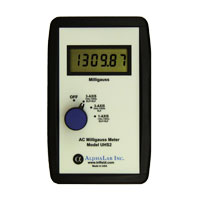
|
A digital gaussmeter for precise measurement of AC magnetic field. This meter measures AC magnetic field in a wide frequency range of 13 Hz to 75 kHz (75,000 Hz). The frequencies include most ELF (that is, frequencies below 1 kHz) and VLF (above 1 kHz) magnetic fields. The meter measures the true 3-axis magnitude of the AC field. Two other more specialized measurements can also be performed: 3-axis VLF-only (1kHz – 75 kHz) to measure the strength of higher-frequency fields, and 1-axis full bandwidth (13 Hz – 75 kHz) to determine the principal direction of the AC magnetic field. Most measurements will be performed with the knob turned to 3-Axis ELF+VLF. This setting is for measurement of true magnitude of magnetic field at the widest range of frequencies (ELF + VLF).  Details
Details
|
|
Natural Electromagnetic (EM) Meter (AlphaLab, USA) |
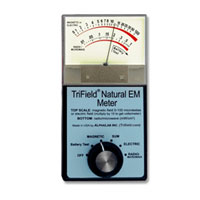
|
A meter that detects small changes in natural DC fields and some radio transients. The TriField Natural EM Meter was designed to do field measurements for special research. It detects changes in extremely weak static (DC or "natural") electric and magnetic fields, and signals with both a tone and the movement of a needle-type gauge if either the electric or magnetic field changes from previous levels. A radio and microwave detector is also included, which reads radio power directly. Because man-made AC electric and magnetic fields are very common and could interfere with readings of static fields, the meter has been designed to ignore AC fields. Normal construction materials don't block magnetic fields, so the meter can be placed indoors and will work equally well, and due to the built-in tone, it can be used in the dark, and will sound the tone at whatever level of field the user sets. Model 1 operates on a standard 9-volt battery, and Model 2 runs on a 9-volt battery or an AC adapter (both included). Model 2 has an input jack for an optional high-sensitivity magnetic coil. Both models are covered by a one-year warranty.  Details
Details
|
|
Earth Magnetometer Model EM2 (AlphaLab, USA) |
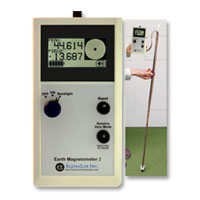
|
The Earth Magnetometer Model EM2 measures the Earth magnetic field with a resolution of 1nT (1 gamma). This resolution is about 0.002% of the typical Earth field strength. It is used to locate buried magnetic objects or materials. • Displays field strength up to 199.999 micro teslas • A relative zero mode subtracts the background field from all subsequent readings so there is only a 1- 2- or 3- digit number to watch. • Backlit display can be turned on. • Lightweight with long battery life (see specifications below). • This is a vector magnetometer so the direction of the field (as well as strength) can be determined (but see full description; this feature requires a longer time per measurement).  Details
Details
|
|
DC Milligauss Meter 3 Axis (AlphaLab, USA) |
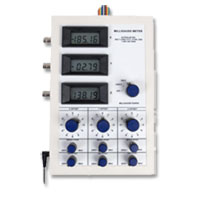
|
An improvement on the flux gate magnetometer, the AlphaLab DC Milligauss Meter measures magnetic fields (technically “flux density”) up to several times the strength of the Earth field. It has a resolution of 0.01 milligauss (1 nanotesla) and a range of +/-2000 milligauss (200 microteslas). The meter's three magnetoresistive sensors are a major improvement over an uncompensated fluxgate magnetometer both in cost and stability. In fact, the sensors approach a proton precession magnetometer in temperature stability. Each of the three displays has an extra digit compared with most portable magnetometers. Each is 4 ½ digits and displays in two ranges: +/- 1999.9 and +/- 199.99 milligauss. Update is three per second. Because the Earth's field is typically about 500 milligauss, nine “offset” controls (three for each of X,Y,Z) allow you to add or subtract up to 600 milligauss with precision of .01 milligauss. Therefore, the Earth's field can be subtracted out when required. If reading in the more sensitive 199.99 range, this field neutralization feature is often necessary, because the field is usually stronger than 200 milligauss. The wide dynamic range of the displays (19,999 count; both polarities), along with the large range of offset (+/- 600 milligauss) and high stability of the meter (+/- .01 milligauss), allow for stable detection of small changes in a large background field. On the higher sensitivity range, changes of .01 milligauss can be reproducibly measured in up to +/- 800 milligauss of background field. On the lower sensitivity range, absolute field of .1 milligauss can be measured in up to +/- 1999.9 milligauss of background field. The sensor is a 25 mm (one inch) cube at the end of cable that is normally four feet long, but other custom lengths are available. Each axis reads negative when pointing toward the south pole of a magnet and positive toward north. At fixed temperature, reproducibility is +/- 0.01 milligauss (1 nT) and the temperature coefficient of the offset is less than 0.01 milligauss/°C. The temperature coefficient for gain is less than .0015%/°C. As shipped, gain accuracy is +/-0.5% and the meter offset is +/- 0.5 milligauss with all offset knobs set at zero. All specifications are at temperatures 0 to 45°C. X,Y,Z are aligned with the cube edges to accuracy one degree unless you specify 1/10 degree in the drop-down box below.  Details
Details
|
|
Zero Gauss Chamber
(AlphaLab, USA) |
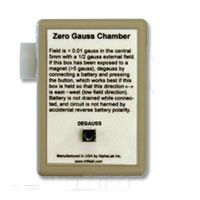
|
Used to "zero" probes for gaussmeters, the ZGC has a built-in degausser and can achieve < 0.002 gauss in a typical external field.
The model ZGC zero gauss chamber reduces the environmental magnetic field (Earth field) to near zero inside the chamber. Any gaussmeter probe which is less than 9.4 mm or 0.370" diameter can be placed inside. The meter is then "zeroed", which means that it will read zero whenever the probe is subsequently placed in zero field. By using a zero gauss chamber, any offset error is therefore eliminated. The model ZGC is unique in that it contains a degausser (demagnetizer). This is situated between the inner and outer mu-metal shields. When the degauss button is pressed, any accidental magnetization of the chamber, no matter how strong, is erased. Accidental magnetization is a major problem with most zero gauss chambers and it has limited their use. If a magnet comes too close, the chamber will become "permanently" magnetized and will have an internal field that is typically 0.2 to 0.5 gauss. The chamber must then be degaussed because the Earth field is also around 0.5 gauss, so a magnetized zero gauss chamber will not significantly reduce the field. Demagnetizing a zero gauss chamber with an external degausser is difficult, even if a degausser is available. Often an external degausser is not strong enough to erase the magnetism of the inner shield, and using a degausser (which is fairly large) is not convenient. When using the ZGC, a single press of the degauss button brings the internal field to less than 0.01 gauss (in all three axes) within a 5 mm wide x 9.4 mm diameter region in the center of the chamber. While the battery is connected, no power is consumed except when the degauss button is being pressed. Even then, a typical 9 volt battery (included) can power over 10 million degauss cycles. After degaussing, the field is < 0.01 gauss regardless of the orientation of the chamber (within the Earth field). If the long axis of the chamber (left-right direction in photo below) is specifically oriented east-west during the degauss, the internal field will be < 0.002 gauss, although most gaussmeters do not require that degree of precision. |

